
Defining learning objectives: a strong and necessary step during learning design
18 June 2020Speaking about training, the learning objectives have a significant role since they allow you to suitable structure your learning activities.
As an example, could you tell the difference between these two sentences?
- “I want to organise briefly a customer meeting”
- “I am capable to organise efficiently a customer meeting within a commercial target”
It seems that the answer is not so easy.
One does not correspond to a learning objective where the other represents a structured one. The first would be more affiliated with the formulation of a desire rather than a learning objective as such.
Before going further into this subject, it is necessary to distinguish between training objectives and learning objectives. Although they are different, they combine the keys to the success of your training modules.
The training objectives correspond to the frame of knowledge, skills and the connotation that will lead the designer to formulate the appropriate learning objectives. On the other hand, the learning objectives serve as a starting point for the designer who will define the specific content and the level of advancement through the training.
The follow reading will help you to understand the significance of learning objectives when it comes to structuring your training and learning activities. Besides, you would understand the ACRE’s methodology and its notion of continuous anticipation.
Through this article, we will provide you some solutions on professional skills improvement, which could be perceived as the strategy of defining learning objectives as an essential stage on the design of training.
Please find below the main topics to help you out with this reading:
- Understanding the cycle of structuring activities.
- Analysing your learners, a discovery stage.
- Formulate your learning objectives accordingly with the training.
- Identify the subjects for improvement.
- Evaluate under the continuous improvement sense.
Understanding the cycle of structuring activities.
Professional Training is a complex field requiring a skillful package of creativity and methodology. These related with how to enable learners to facilitate the development of their skills.
Constructing training courses involves the respect of some stages to achieve the main target. Analyse and understand the learner’s profile it’s the first step in this cycle. After that, the Design of the training establishes the structure including the topics the designer wants to work out. The general objective of the training is defined at this stage. With these two completed, the Set-up of those objectives allows at the same time significant feedback on the process itself to adjust the content for future versions of the project. Finally, the Evaluation stage including the criteria to measure the content achieved through the training.
This Cycle is based on four supports :
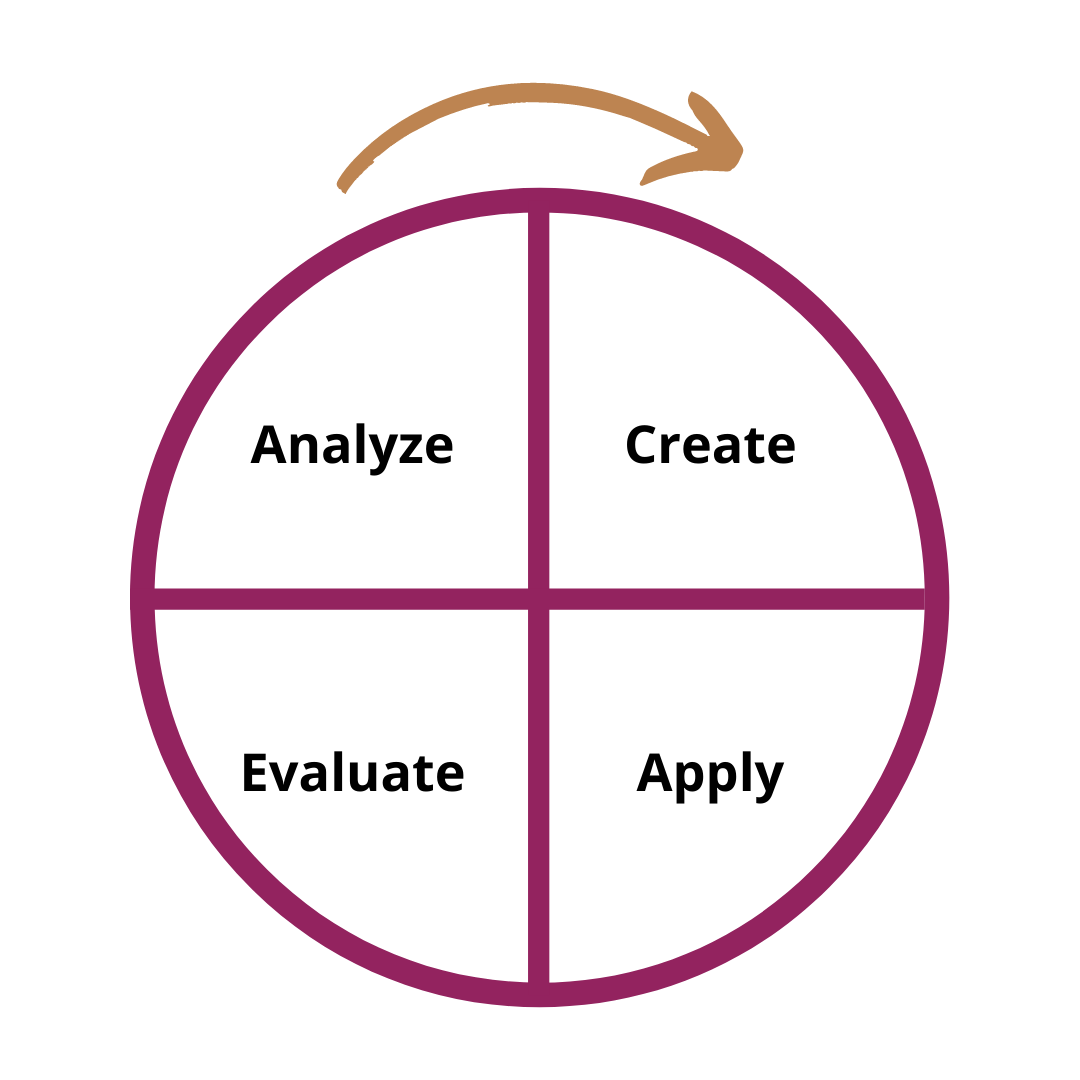
Perceived in a clockwise direction, these supports establish this methodology initiated by Thierry Ardouin (ACRE – {in french} Analyse, Conception, Réalisation, Évaluation). ACRE conducts under a continuous improvement approach for future training versions.
ACRE methodology could be compared to the ADDIE model which is also based on several supports: Analysis, Design, Development, Implementation and Evaluation. Unlike ACRE, ADDIE includes an additional focus on implementation related to the access to training for learners. To face-to-face training, for example, a permission to the classroom is necessary as well as the booking for the room. For digital training, the attention is focused on the launching settings. For instance, ACRE and ADDIE could be match with PDCA methodology (Plan, Do, Check, Act). This last focused on quality outcomes.
Let’s see ACRE supports on detail.
Analysing your learners, a discovery stage.
This stage allows you to understand who your learners are. This action is not exclusively focused on this phase, but it remains unquestionable for the rest of the process. Analyse your learners it’s a major action since they are the main performers of the learning activity. It is conceived that learners should put in practice what they have learnt, this action remains a key feature for any training. Understanding your learners means anticipating the future impact of your training.
Consider your learner’s needs, their possible expectations, and above all, their background on the topic. The ambition at this point is to allow them to follow a suitable training. It’s a primary action to enable them to improve their skills by contesting the established training objective.
The assimilation of knowledge by learners also involves activities that will stimulate their interest. Adding a human dimension (knowledge about the learner) allows designers to adapt their content and teaching activities. Diversifying these activities such MCQ, gap-filling text, video, audio, reading, etc. contributes to this action.
Pascal Marquet’s instrumental conflict concept (2006) explains the notion about how learning could be structured between teaching content, its set-up and its access on digital learning platforms. You can hear more about his concept on the sixth podcast of the Digital Learning Makers – The My-Serious-Game Podcast – named “Digital at the service of learning”. Analysing learners allows to define the learning objectives. You could anticipate what your audience is interested in to define the structure of your training. “Today learner, tomorrow trainer” article shows how an objective must stimulate the learner’s attention.
Articulate your learning objectives with your training
The second phase of ACRE’s methodology is the Design phase.
Training is a complex field that needs to be methodological. To obtain a well-structured activity, it relies on the choice of its learning objectives. After analysing your learners, you can start defining your learning intentions. The success in terms of structure relies on the coherence or “Taxonomy” among these intentions and how they respond to the main objective of your training.
Benjamin Bloom introduced in 1956 a framework for categorized learning objectives in 6 major categories: Knowledge, Comprehension, Application, Analysis, Synthesis and Evaluation. These categories present a set of abilities and skills to work on, going from simple to complex, to obtain a better cognitive output.
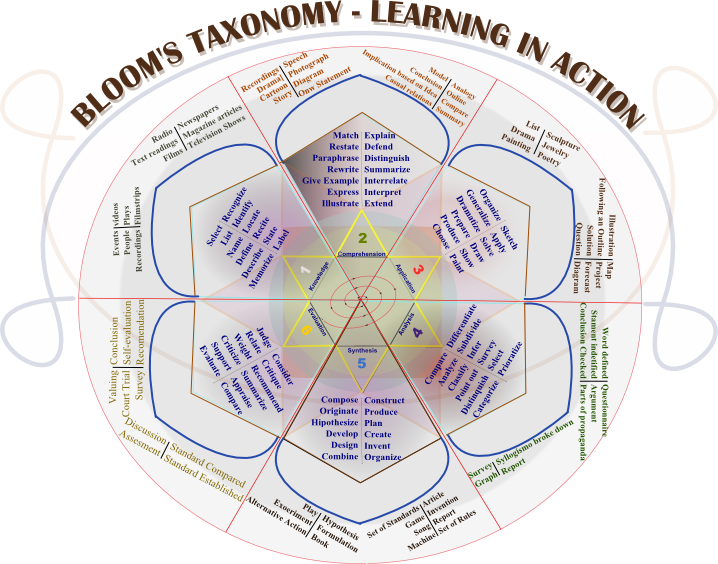
Let’s take this as example: “To efficiently organize a customer meeting under a commercial perspective”. In this case “to organize” is the main action which is one of the highest levels for the taxonomy. In order to achieve this goal, it is necessary to include lower levels of learning intentions.
This goal could be illustrated by the following lower levels:
- Defining the objective of the meeting with the client: categories 1 and 2
- Identifying the company and its intention: categories 1 and 2
- Classifying the corresponding need of the product: categories 3 and 4
Imagine then a staircase where each step is equivalent to an objective leading to the shaping of the different activities.
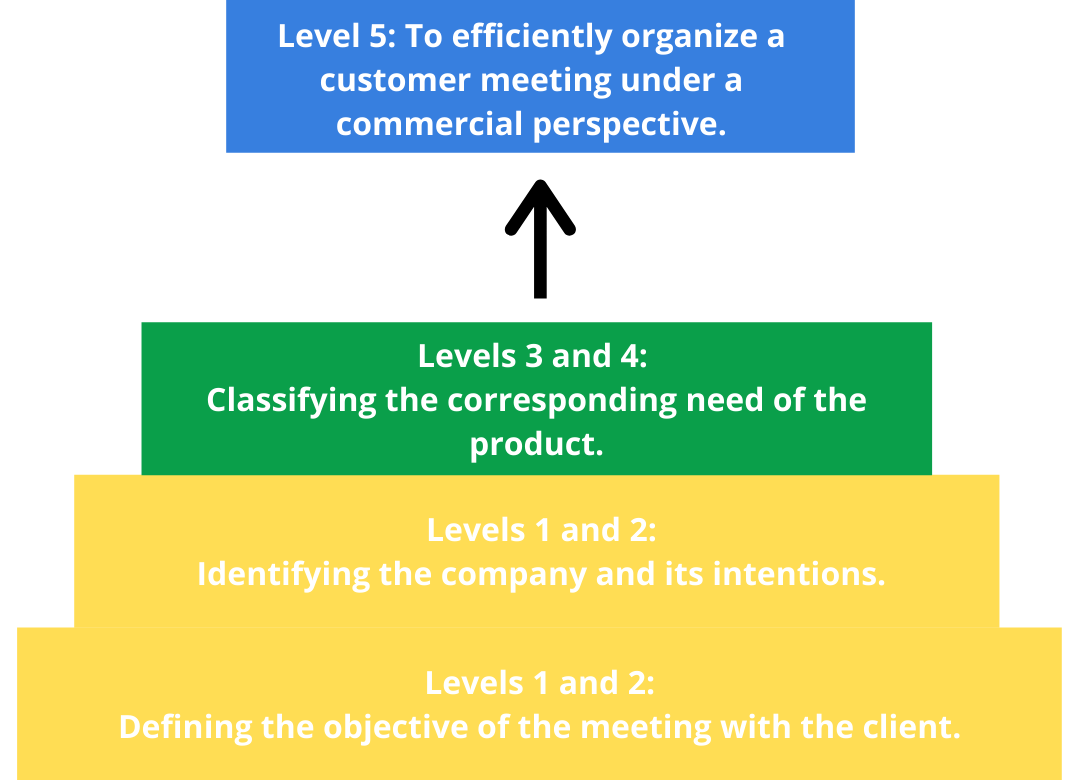
- Level 5: To efficiently organize a customer meeting under a commercial perspective.
- Levels 3 & 4: Classifying the corresponding need of the product.
- Levels 1 & 2: Identifying the company and its intentions.
- Levels 1 & 2: Defining the objective of the meeting with the client.
Despite the variety of methods, EdMill has deployed its counseling strategy using Bloom’s Taxonomy to classify cognitive skills. Through our authoring tool, you will design your trainings by defining your main goal and then the learning intentions (objectives) to gradually reach the training objective.
We stipulate that for an effective course, the chosen category will determine the learning objective’s levels. As a result, we have structured in 3 coloured levels the categories for the learning design:
- Yellow: Theorical knowledge (Levels 1 & 2)
- Green: Applied knowledge (Levels 3 & 4)
- Blue: Practical knowledge (Levels 5 & 6)
With our example:
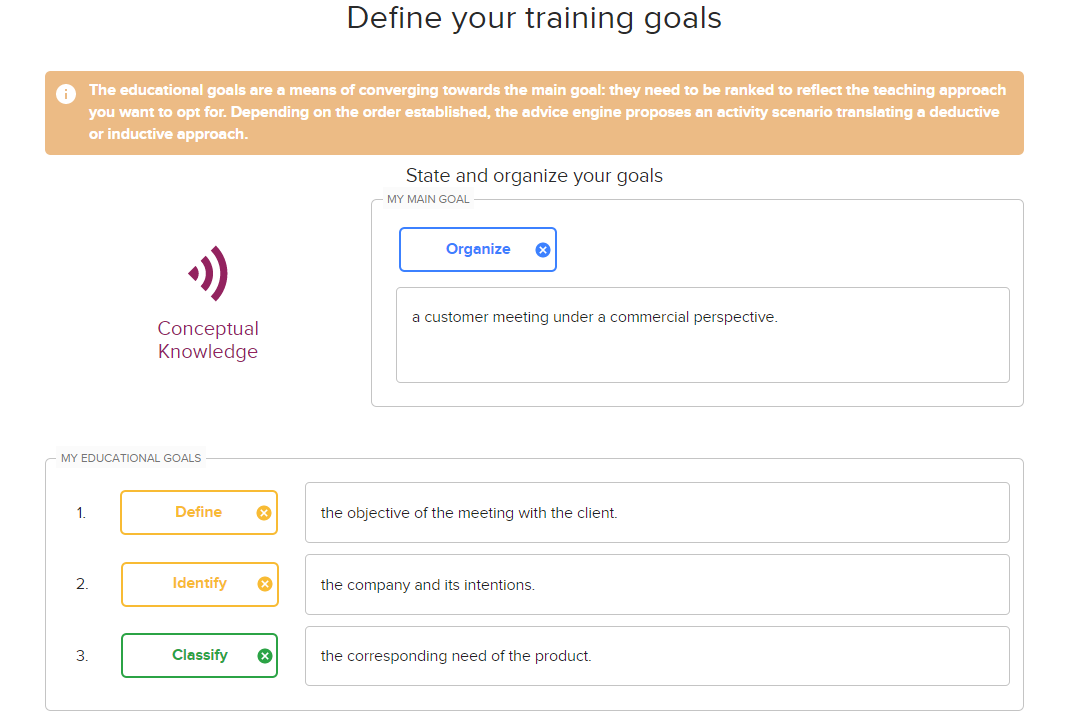
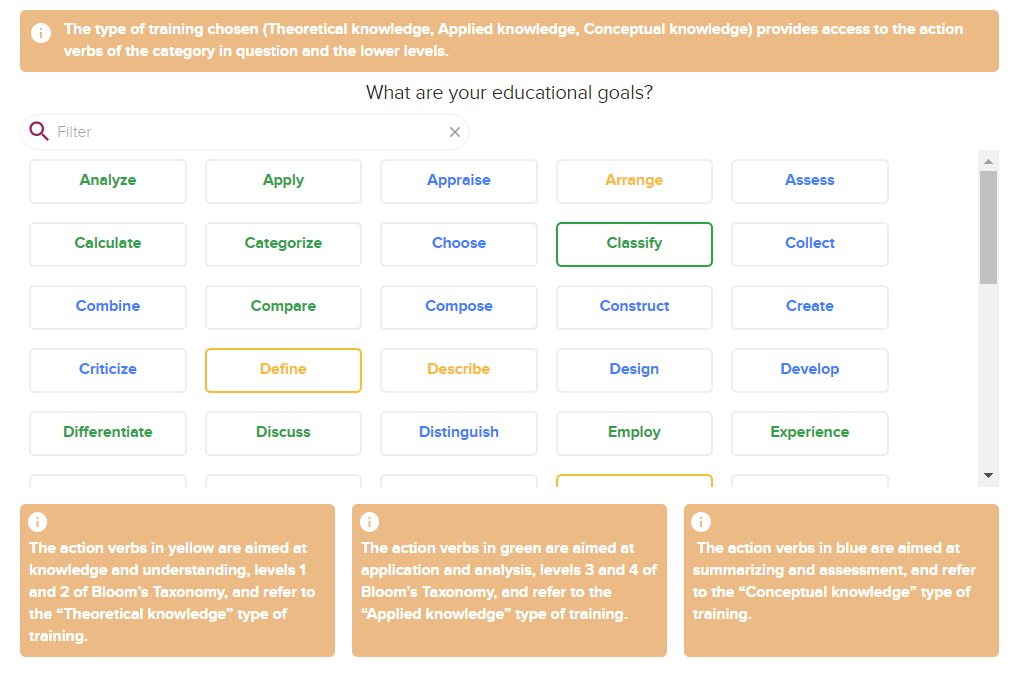
Learning objectives make possible to achieve a main course goal. They also allow trainers and designers to identify if this goal and knowledge have been acquired. Nevertheless, they are not the only primary element on the design of your course. In order to achieve tangible results, it is indispensable to structure those activities into a larger framework.
EdMill focuses on the design of training courses using a larger framework. We hypothesize that the use of this framework, assisted by the structure of learning objectives, contribute to better and efficient results. To achieve conclusive outcomes, we have organized a training course in those stages:
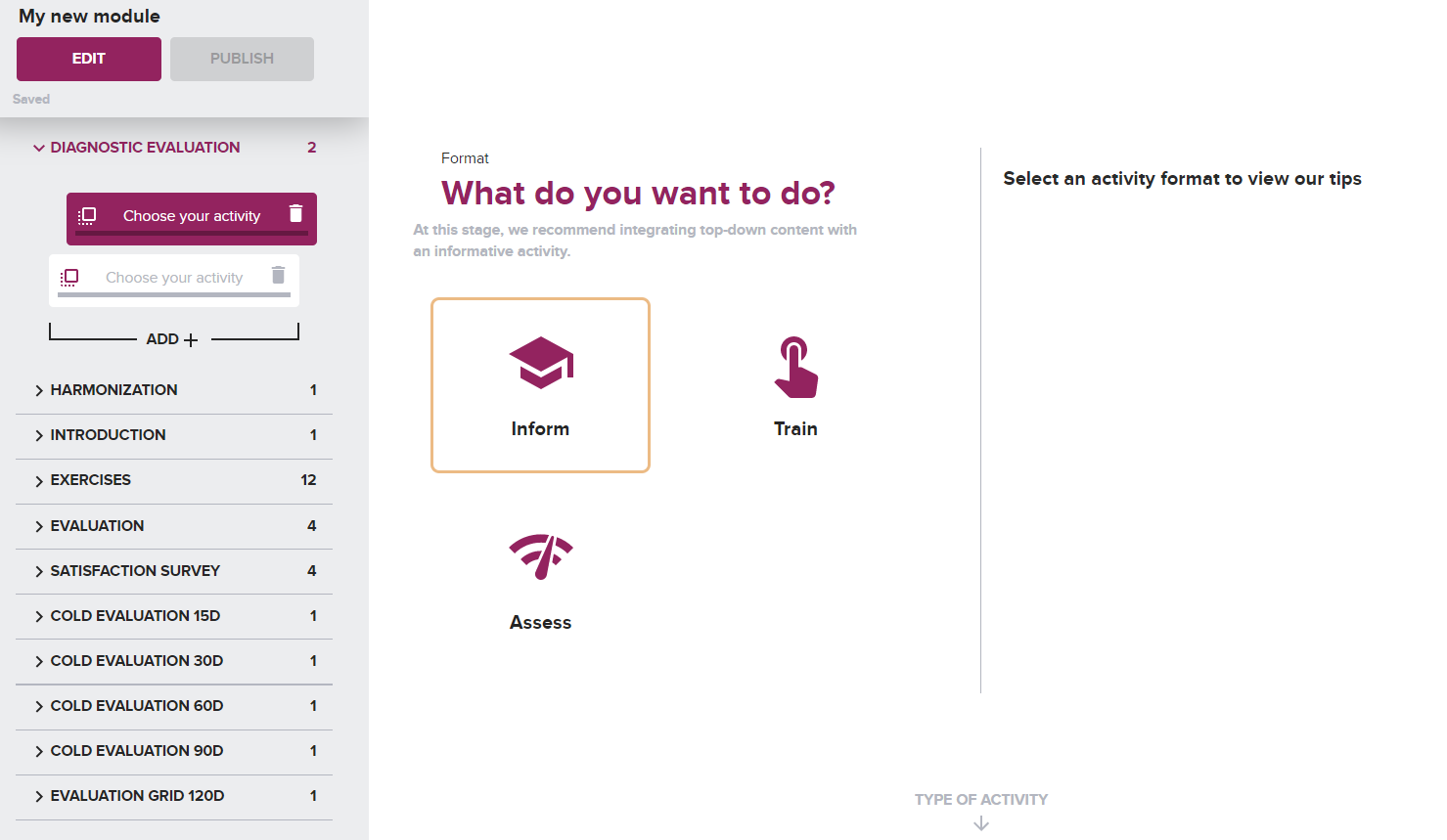
- Diagnostic assessment: which takes places at the beginning, offers a clear overall view of the reality about learner’s knowledge level.
- Alignment: after diagnostic, it allows designers to align training structure and objectives.
- Introduction: opening of training goal and learning intentions.
- Activities: learning activities disposed to work on learner’s skills.
- Assessment: it allows the measurement of knowledge.
- Summary: after assessment, it’s a moment for a feedback from learners about the module.
- Monitoring protocol: measuring learning outcomes over a defined period of time according to training objectives.
According to our experience, a well-structured sequence of learning objectives matched with a dynamic framework, would obtain better performances and outcomes from learners.
Perform to improve.
With the learning objectives defined and the structure of the training fixed, it is time to run the course. The result determinates the status of the expectations from the training and allows an improvement strategy. This stage is essential because it highlights possible errors about the content and the structure of the course. The feedback given by learners to trainers makes improvement possible, due to the fact that this information is reviewed and translated into upgrading achievements for future training sessions.
The trainers become then “master of the game” because they possess the content knowledge and the results to improve the course. At this stage, the design action reveals if the training has been correctly executed in correlation with the established goals. For us, this action uncovers a continuous improvement strategy which is required at any level on the skills improvement field.
Assess within a continuous improvement strategy.
This last but significant stage in ACRE’s method is the assessment. It is presented as a turning point for future realisations. Donald Kirk Patrick in 1959 established an assessment strategy to analyse the effectiveness and impact of training programs. According to this model, the outcome of the training can be measured at four levels: Reaction, Learning, Behaviour and Results.
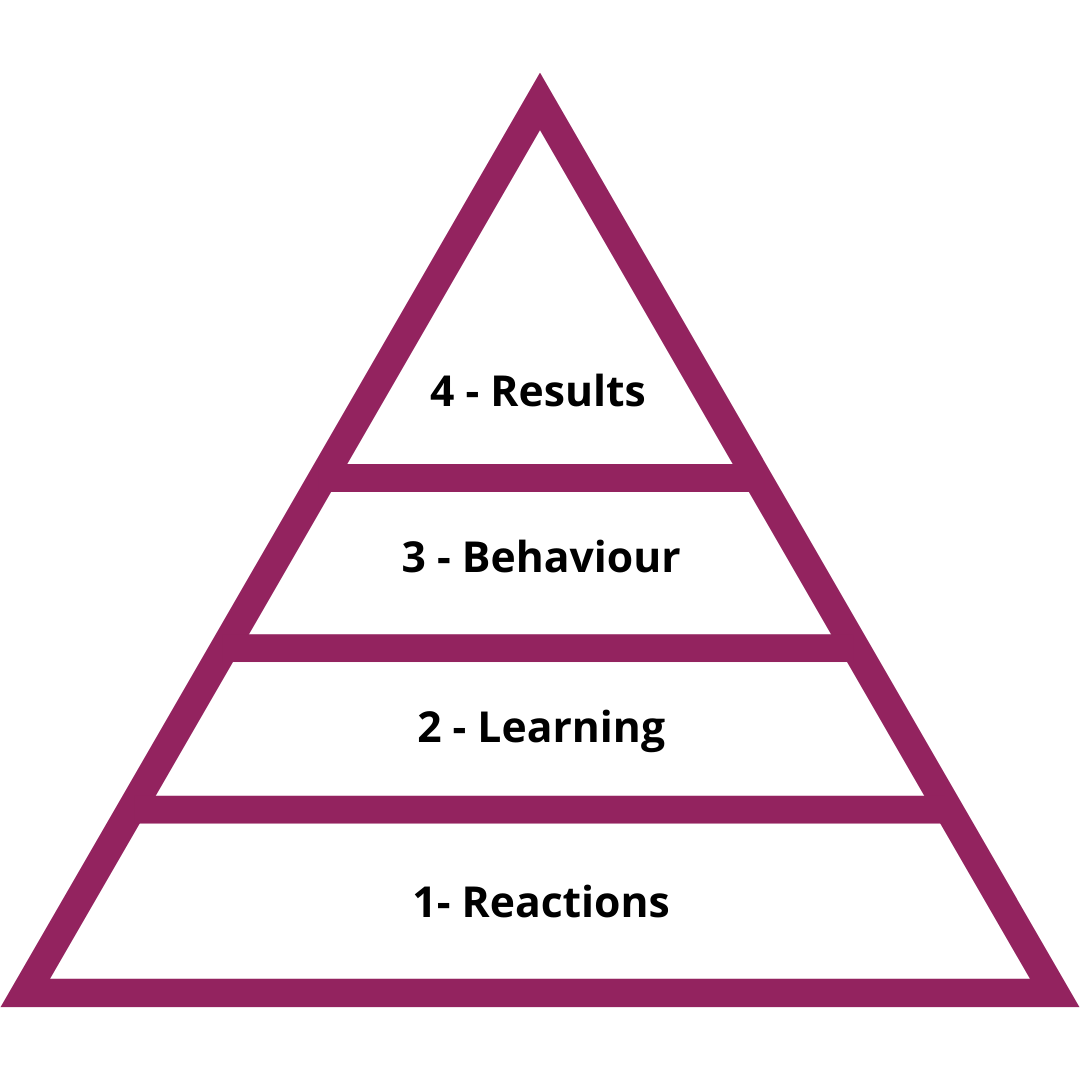
From bottom to top:
Level 1 – Reactions: To measure learner’s satisfaction, specifically to training and its relevance to their level of involvement (satisfaction survey).
Level 2 – Learning: To measure the levels of knowledge or skills that learners have acquired during training (knowledge quiz)
Level 3 – Behaviour: Direct measurement of learning outcomes at the end of the course, which is equivalent to observing learner’s abilities in a particular situation (observing how the learner handles a new software).
Level 4 – Results: To measure the impact and improvement through learner’s performances results. This aspect allows you to differentiate between expected results and the actual ones.
Key Performance Indicators (KPI) allow to measure properly those levels. Those indicators confirm if the learning objectives have been applied in substantial results. Other indicators ROI (Retour On Investment), introduced by Jack Phillips in 1990 and ROE (Retour On Expectations) introduced by James D. Kirkpatrick and Wendy Kayser Kirkpatrick after the main Kirkpatrick’s model are as well used to measure those performances.
The “ROI” indicator is still used for training courses but hardly applicable since it only concerns the financial effect. ROI applies a particular formula “for X invested money on a training, Y money would be perceived”. This approach underestimates other dimensions in terms of learning, which is the case of the human dimension anticipating the benefits of your training courses. On the other hand, ROE clearly could help us to define our training goals even before the beginning anticipating possible feedback and results from learners.
Applying this method requires several steps to be followed:
- Discussing with those involved in the training to understand their expectations
- Defining short-term indicators
- Defining the operational objectives of the training (Organising a meeting)
- Training design and monitoring
- Evaluation of ROE
Measuring a training course combines essentially ROI and ROE. The first one allows leaders and managers to assess the financial aspect and impact for companies. ROE allows to change training perception, due to the fact that it is charged with a larger human perception to the positive impact on organisational results. As ROI indicator involves training participants, such learners, designers and stakeholders, it becomes a significant aspect to consider on the process of training design methodology. This is as well perceived as an constant improvement cycle to evaluate training courses.
Conclusion
To conclude, training must be conceived as a veritable cycle process (Analysis, Design, Perform and Assess).
- Analysing learners is essential since it allows them to contribute to the process of designing by adapting their knowledge level to the future topic. The inputs would be considered in order to adapt the learning objectives of the future course through dynamic activities.
- Keeping an adapted methodology for your design courses should not be neglected. The use of Bloom’s Taxonomy would simplify the course structure and it could help you to summarize a better course.
- Performing the course give the trainer positive points and areas of improvement. Trainers play a significant role since they will obtain a feedback from learners to determine the areas of improvement. This action could also highlight what trainers have designed to share among their pairs.
- Finally, evaluate the learners involves a collection of data about not only the score but their interest, knowledge, skills and capabilities. This stage has to be careful studied at the beginning of the training under an anticipation strategy.
We consider that the respect of these stages gives to your learning objectives and your module design a clear structure obtaining effective and positive results.
Did you know that EdMill’s authoring tool is based on this approach?




